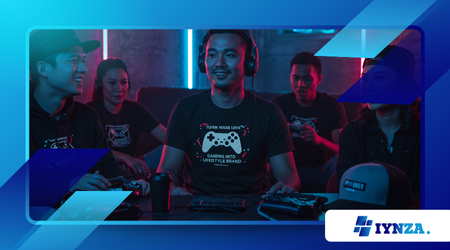How to Turn Your Love for Gaming into a Lifestyle Brand

Gaming isn’t just a hobby anymore—it’s a culture. It influences fashion, music, media, and identity. For many, it’s not just what they do in their free time.
Anúncios
It’s who they are. If you’re one of those people, you’ve probably wondered how to take that passion and build something bigger from it. The answer lies in learning how to turn your love for gaming into a lifestyle brand.
It’s not about creating merch overnight or launching a YouTube channel just for views. It’s about building a voice, a visual identity, and a purpose that others can connect with—because they see themselves in it. This article shows you how to make that leap.
Define the Core Identity of Your Brand
Every brand starts with a belief. Yours should grow from what gaming means to you—not just what games you play. Do you care about nostalgia, community, competition, or creativity? Are you drawn to retro aesthetics, modern esports, or cozy narrative games?
Turning your love for gaming into a lifestyle brand begins with clarity. Without that, everything else falls apart.
This foundation defines your tone, your design language, your content style, and your audience. Are you building for hardcore players? For casuals who care more about aesthetic than ranking? Women in gaming? For indie game lovers? Make that focus intentional.
The most powerful brands don’t appeal to everyone—they resonate deeply with someone. Start there.
Read also: How to Build the Ultimate Retro Gaming Setup
Build a Visual World That Reflects Your Message
Once you know what your brand stands for, you need to express it visually. That includes your logo, your colors, your typography, your video format, your merch design—everything.
Your aesthetic should immediately tell someone what you’re about. Whether it’s minimalist and clean or chaotic and full of energy, consistency is key. That’s how people start recognizing you, remembering you, and eventually trusting you.
You don’t need a huge budget. Start with Canva, Figma, or even templates. The goal isn’t to be perfect—it’s to be cohesive. If you post on TikTok, your style should match your Instagram and your website. If you sell clothing, the packaging should feel like your content.
In gaming, visuals speak fast. Make yours count.
Create Content That Turns Passion into Connection
Content is what turns attention into community. Whether you’re streaming, posting on socials, or designing products, your goal is to make others feel seen.
If your brand is about retro gaming, show off your collection, share hot takes on old titles, or explain why they still matter. If it’s about inclusivity, talk about representation, spotlight indie games with diverse characters, and engage with those conversations.
Gaming content doesn’t need to follow trends—it needs to follow emotion. What’s personal to you often resonates most with others.
Build in public. Show the behind-the-scenes of building your brand. Let people see the process. That’s what creates loyalty.
Collaborate and Engage With Communities That Already Exist
You don’t build a lifestyle brand in a vacuum. You grow by connecting to what’s already thriving.
Find creators who share your values, support others in your niche, and engage genuinely in comments and chatrooms. Join Discord servers, subreddit discussions, and niche platforms—not just to promote, but to participate.
Your first fans will likely come from people who already care about the same things you do. Meet them where they are.
Collaborations—whether it’s a podcast guest spot, a co-designed item, or a shared video—also accelerate reach and legitimacy. But only if they feel authentic. Forced collabs rarely convert into lasting support.
Turn Your Audience Into Advocates Through Meaningful Products
Once you have a consistent identity, visual language, and community, you can start turning that into products. But don’t just print your logo on a hoodie and call it a brand.
Create items that feel like extensions of your message. If your brand is about cozy, solo gaming experiences, design weighted blankets, mugs, or notebooks that reflect that. If you’re about high-performance competitive gaming, create sleek apparel or gear that reflects focus and intensity.
Every product should answer this question: “Would someone wear or use this because it reflects something about them, not just me?”
Your audience becomes your advocate when they feel represented. Make products that let them show who they are—through what you’ve built.
A Core Truth Behind Every Gaming Brand That Works
Lifestyle brands grow when identity and community meet. People don’t follow for what you sell. They follow because of how you make them feel about themselves.
A 2024 survey by Creator Economy Weekly found that 58% of gamers aged 18–30 have purchased at least one item from a gaming-inspired lifestyle brand in the past year. Among them, 72% said they did so because the product “represented who they are” more than the specific game or creator it came from.
Authenticity sells better than visibility.
Conclusion
Learning how to turn your love for gaming into a lifestyle brand isn’t about being the loudest or most viral. It’s about knowing what you stand for, building consistency around it, and giving others a way to feel connected through it.
Start small. Speak clearly. Build trust. Let your content, your visuals, and your products reflect not just what you love—but who you are.
Because in the end, the most successful brands aren’t just built on passion. They’re built on purpose.
FAQ
1. Do I need to be a content creator to build a gaming lifestyle brand?
No, but content helps amplify your voice and build trust with your audience.
2. Can I build a brand without selling merchandise?
Yes. Lifestyle branding starts with identity and connection. Products come later.
3. Is there space for new gaming brands in 2025?
Absolutely. The market keeps expanding, and there’s room for niche, focused voices.
4. Do I need a large audience to launch a product?
Not necessarily. Even a small, engaged community can support meaningful product drops.
5. What’s the biggest mistake new gaming brands make?
Trying to appeal to everyone instead of focusing on a clear, personal message.
